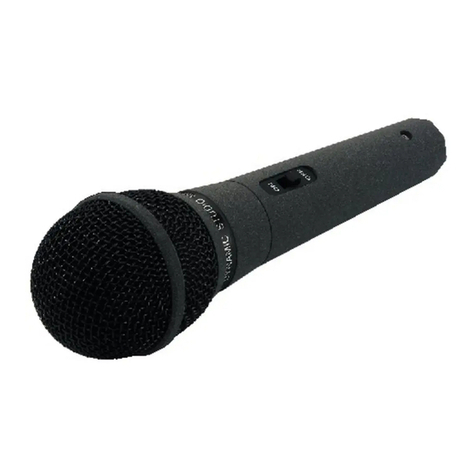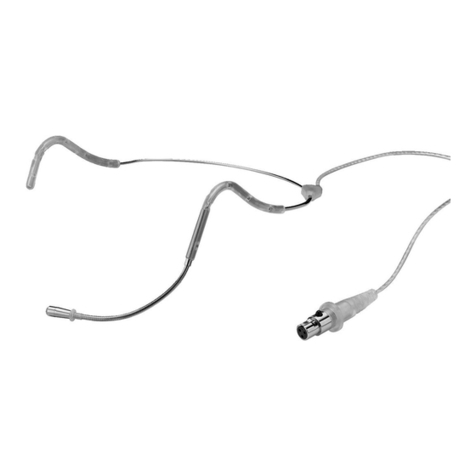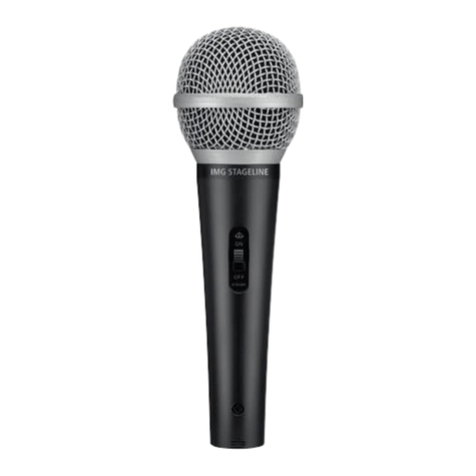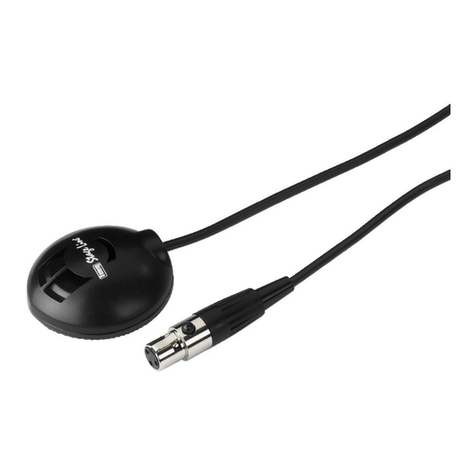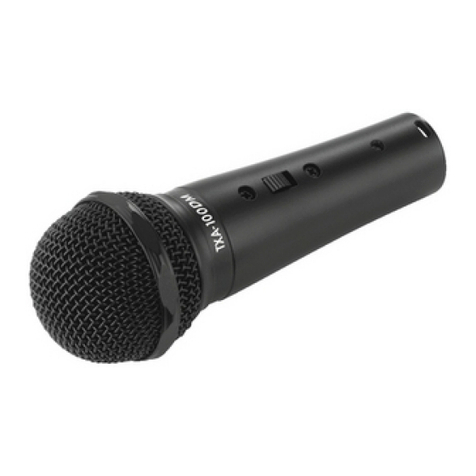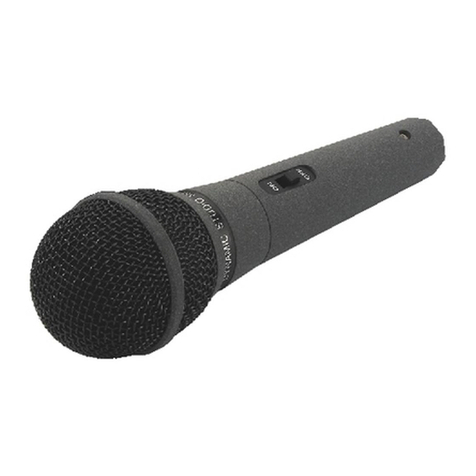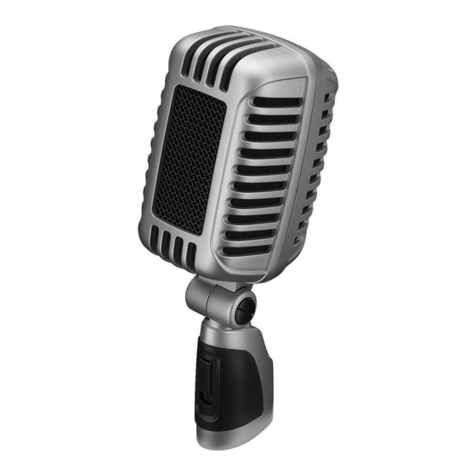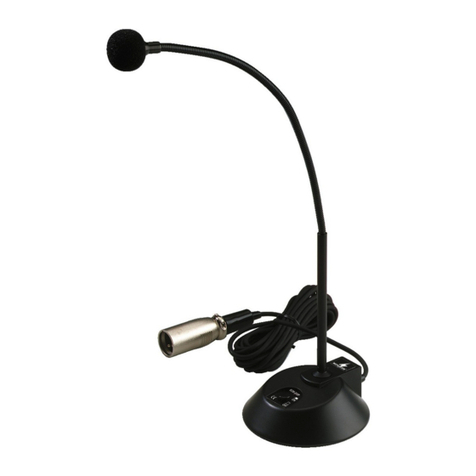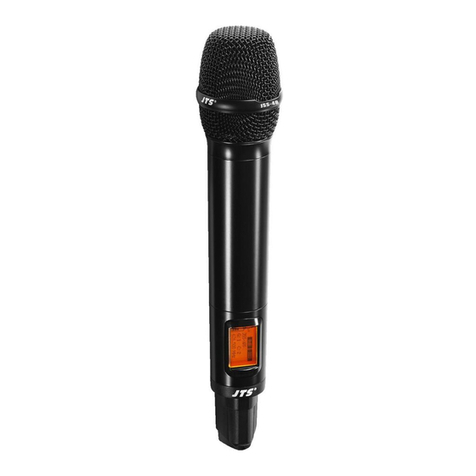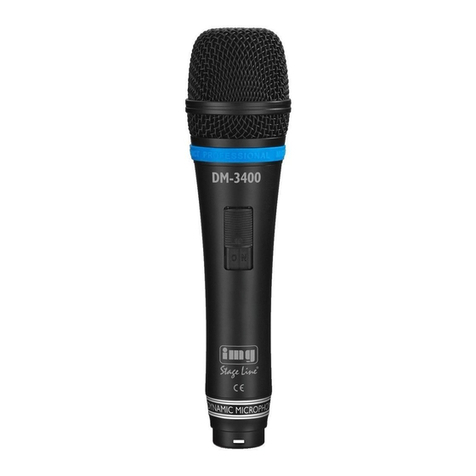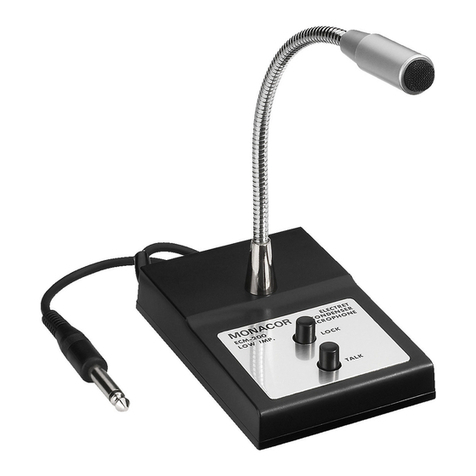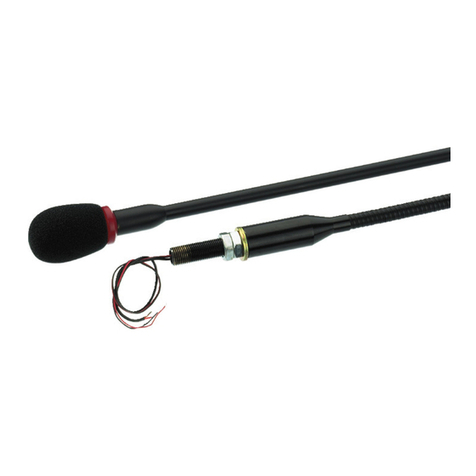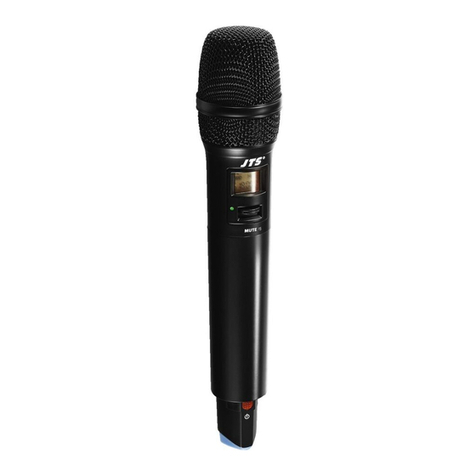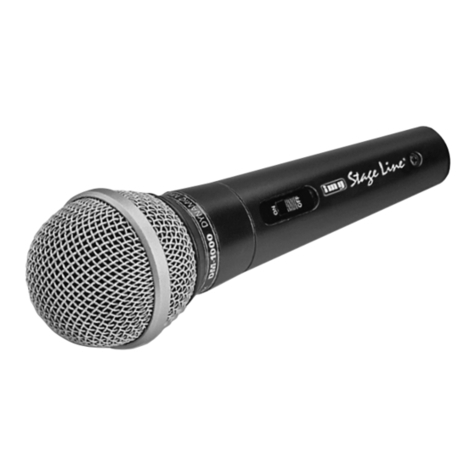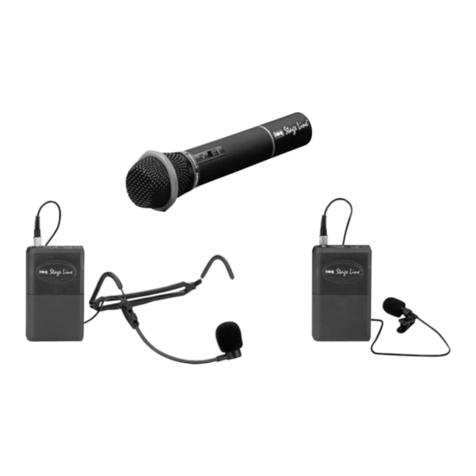Microfono a elettrete
a collo di cigno
Vi preghiamo di leggere attentamente le presenti
istruzioni prima della messa in funzione e di conser-
varle per un uso futuro.
1 Possibilità dʼimpiego
Questo microfono a collo di cigno con ottime caratteri-
stiche di trasmissione e con eccellente comprensione
della lingua parlata è adatto in particolar modo per
avvisi, conferenze o altre trasmissioni di lingua parlata
dove è richiesto un microfono fisso. Può essere inserito
direttamente su un contatto XLR per microfono oppure
può essere impiegato, insieme alla base DMS-1 o
DMS-3 del programma di “img Stage Line”, come
microfono da tavolo. Per il funzionamento del microfono
è richiesta lʼalimentazione phantom (9 – 48 V).
2 Avvertenze di sicurezza
Il microfono è conforme a tutte le direttive richieste
dellʼUE e pertanto porta la sigla .
GUsare il microfono solo allʼinterno di locali e proteg-
gerlo dallʼacqua gocciolante e dagli spruzzi dʼac-
qua, da alta umidità dellʼaria e dal calore (tempera-
tura dʼimpiego ammessa fra 0 e 40 °C).
GPer la pulizia usare solo un panno morbido, asciut-
to; non impiegare in nessun caso prodotti chimici o
acqua.
GNel caso dʼuso improprio, di collegamenti sbagliati,
o di riparazione non a regola dʼarte del microfono,
non si assume nessuna responsabilità per even-
tuali danni consequenziali a persone o a cose e non
si assume nessuna garanzia per il microfono.
3 Messa in funzione
1) Applicare la spugna antivento (1) in dotazione sul
microfono.
2) Inserire il microfono su un contatto XLR per
microfono oppure su una base per microfono. Lʼin-
gresso microfono deve disporre di unʼalimenta-
zione phantom (9 – 48 V). Altrimenti collegare il
Se si desidera eliminare il microfono definiti-
vamente, consegnarlo per lo smaltimento ad
unʼistituzione locale per il riciclaggio.
microfono per mezzo di un alimentatore phantom
separato (p. es. EMA-3, EMA-200, EMA-400 del
programma “img Stage Line”) con lʼapparecchio
audio. Non appena lʼalimentazione phantom è
applicata, si accende la spia di funzionamento (3).
3) Orientare il microfono in modo ottimale con lʼaiuto
del collo di cigno (2).
4) Per attivare il filtro Low-Cut (passa-alto 180 Hz,
12 dB/ottava) [abbassamento dei bassi per com-
pensare lʼeffetto di prossimità], spostare lʼinterrut-
tore (4) in posizione .
4 Date tecnici
Tipo di microfono: . . . . . . elettrete
Caratteristica direzionale: cardioide
Gamma di frequenze: . . . 30 – 18 000 Hz
Sensibilità: . . . . . . . . . . . . 4,5 mV/Pa con 1 kHz
Impedenza: . . . . . . . . . . . 180 Ω
Max. pressione sonora: . . 130 dB
Alimentazione: . . . . . . . . . alimentazione phantom
9–48V
Dimensioni: . . . . . . . . . . . ∅9/19 mm × 600 mm
Collegamento: . . . . . . . . . XLR, simmetrico
Con riserva di modifiche tecniche.
Micrófono electret
de cuello de cisne
Por favor, lea estas instrucciones de funcionamiento
cuidadosamente antes de usar el aparato y guárdelas
para usos posteriores.
1 Usos
Este micrófono de cuello de cisne de muy buenas
características de transmisión y excelente inteligibilidad
de palabra está especialmente indicado para anuncios,
lecturas, u otra transmisión de habla que requiera un
micrófono estático. Puede ser colocado directamente
en una conexión de micrófono XLR. Alternativamente,
junto con la base de micrófono DMS-1 o DMS-3 de la
gama de productos de “img Stage Line”, puede ser
usado como micrófono de mesa. Para utilizar el micró-
fono se requiere una alimentación phantom (9 – 48 V).
2 Notas para el uso seguro
Este micrófono corresponde a todas las Directivas
requeridas por la UE y por eso está marcado con .
GEl micrófono sólo está indicado para su uso en inte-
rior. Protéjalo contra proyecciones de agua, salpi-
caduras, humedad elevada del aire y calor (tempe-
ratura de funcionamiento admisible 0 – 40 °C).
GPara la limpieza use sólo un paño seco y suave; no
use nunca productos químicos o agua.
GNo se aceptará ninguna reclamación para el micró-
fono ni responsabilidad alguna en caso de daños
personales o materiales resultantes si el micrófono
se usa para otros fines que los que se idearon ori-
ginalmente, si no se conecta correctamente, o si no
se repara de manera experta.
3 Funcionamiento
1) Coloque la protección para el viento/anti-ruido (1)
en el micrófono.
2) Inserte el micrófono en una entrada de micrófono
XLR o una base de micrófono. La entrada de mi-
crófono debe estar provista de una alimentación
phantom (9 – 48 V). Si no, conecte el micrófono
mediante una unidad de alimentación phantom se-
Si el micrófono debe ser puesto fuera de fun-
cionamiento definitivamente, llévelo a un
centro de reciclaje local para su eliminación
no contaminante para el medio ambiente.
parada (por ejemplo los EMA-3, EMA-200, EMA-
400 de la gama de de productos de “img Stage
Line”) a la unidad de audio. Tan pronto como el mi-
crófono es alimentado con alimentación phantom,
el indicador de funcionamiento (3) se enciende.
3) Ajuste el micrófono de una manera óptima con el
cuello de cisne (2).
4) Para encender el filtro low cut (high pass 180 Hz,
12 dB/octava) [atenuación baja para compensar
el efecto de proximidad], coloque el interruptor (4)
en la posición .
4 Características técnicas
Tipo de micrófono:. . . . . . electret
Característica: . . . . . . . . . cardioide
Índice de frecuencia: . . . . 30 – 18 000 Hz
Sensibilidad: . . . . . . . . . . 4,5 mV/Pa a 1 kHz
Impedancia: . . . . . . . . . . . 180 Ω
Presión máxima de sonido:130 dB
Alimentación: . . . . . . . . . . phantom 9 – 48 V
Dimensiones: . . . . . . . . . . ∅9/19 mm × 600 mm
Conexión:. . . . . . . . . . . . . XLR, simétrica
Sujeto a modificaciones técnicas.
Mikrofon elektretowy
na gęsiej szyi
Prosimy o uważne przeczytanie poniższej instrukcji
przed użyciem urządzenia, oraz o zachowanie tekstu
do wglądu.
1 Zastosowanie
Mikrofon na gęsiej szyi EMG-650P cechuje bardzo
dobra charakterystyka transmisji oraz doskonała czy-
telność komunikatów słownych, dzięki czemu znaj-
duje idealne zastosowanie przy zapowiedziach,
wykładach, czy transmisji mowy innego rodzaju, dla
których wymagany jest mikrofon stacjonarny. Mikrofon
EMG-650P można podłączyć bezpośrednio do złączy
mikrofonowych XLR, może on być również stosowany
jako mikrofon pulpitowy, w połączeniu z mikrofonową
podstawką stołową z oferty “img Stage Line”: DMS-1
lub DMS-3. Do poprawnego funkcjonowania mikrofon
wymaga zasilania fantomowego (9 – 48 V).
2 Bezpieczeństwo użytkowania
Urządzenie spełnia wymogi norm obowiązujących w
Unii Europejskiej, jest zatem oznaczone symbolem .
GUrządzenie przeznaczone jest do użytku jedynie
wewnątrz pomieszczeń. Należy chronić je przed
bezpośrednim kontaktem z wodą, przed działaniem
wilgoci oraz wysokiej temperatury (dopuszczalna
temperatura otoczenia pracy to 0 – 40 ºC).
GDo czyszczenia urządzenia należy używać suchej,
miękkiej tkaniny; nie wolno stosować wody, ani
chemicznych środków czyszczących.
GProducent ani dostawca nie ponoszą odpowie-
dzialności za wynikłe szkody (uszkodzenie sprzętu
lub obrażenia użytkownika), jeśli urządzenie było
używane niezgodnie z przeznaczeniem, lub jeśli
zostało nieprawidłowo podłączone, bądź poddane
nieautoryzowanej naprawie.
3 Obsługa urządzenia
1) Należy nałożyć na mikrofon osłonę przeciw-
wietrzną (1).
2) Należy podłączyć mikrofon do wejścia mikrofono-
wego XLR lub do mikrofonowej podstawki stoło-
wej. Na wejściu mikrofonowym musi być obecne
napięcie fantomowe (9 – 48 V). W innym wypadku
Jeśli urządzenie ma zostać ostatecznie
wycofane z użycia, należy przekazać je do
punktu utylizacji odpadów, aby uniknąć
zanieczyszczenia środowiska.
należy podłączyć mikrofon do urządzenia audio
przez zewnętrzny zasilacz fantomowy (np. z oferty
firmy “img Stage Line”: EMA-3, EM-200, EMA-
400). Gdy mikrofon zostanie zasilony napięciem
fantomowym, zapali się wskaźnik pracy urządze-
nia (3).
3) Należy wyregulować optymalne ustawienie mikro-
fonu za pomocą gęsiej szyi (2).
4) Aby włączyć filtr dolnozaporowy (górnoprzepust.
180 Hz, 12 dB/oktawę) [tłumienie niskich tonów
dla kompensacji efektu bliskości], należy ustawić
przełącznik (4) w pozycji .
4 Dane techniczne
Typ mikrofonu: . . . . . . . . . elektretowy
Charakterystyka: . . . . . . . kardioida
Pasmo przenoszenia: . . . 30 – 18 000 Hz
Czułość: . . . . . . . . . . . . . . 4,5 mV/Pa/1 kHz
Impedancja: . . . . . . . . . . . 180 Ω
Maks. SPL: . . . . . . . . . . . 130 dB
Zasilanie: . . . . . . . . . . . . . napięcie fantomowe
9 – 48 V
Wymiary: . . . . . . . . . . . . . ∅9/19 mm × 600 mm
Połączenie: . . . . . . . . . . . XLR, symetryczne
Z zastrzeżeniem możliwości zmian.
EMG-650P
Best.-Nr. 23.4330
www.imgstageline.com


